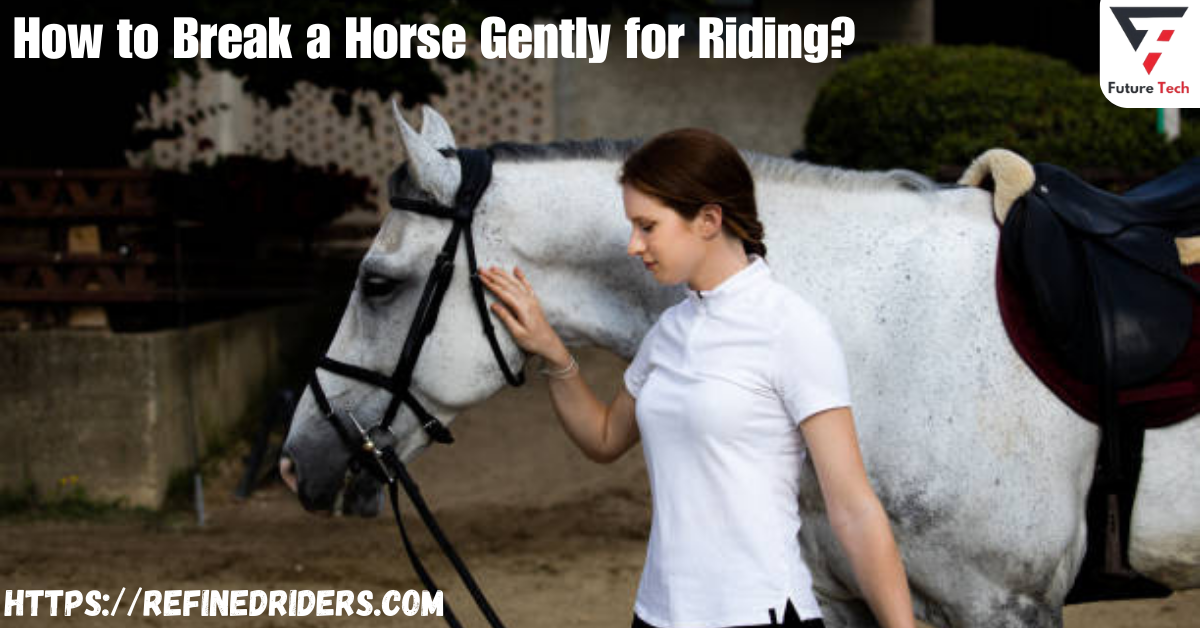When you first obtain a horse, you’ll want to ride it to get to know it and vice versa. However, you can’t ride an unbroken horse since it won’t let you put a saddle on it. Then, you may wonder, what is the best way to train a horse? The good news is that, with practice and planning, you can accomplish it on your own. Okay, I’ll check out the big deal. To “break” a horse is to teach it how to carry a rider. The term “breaking” originally meant to tame unruly horses, but the word’s meaning has evolved.
Easy activities like putting on a bridle or saddle or carrying a rider willingly are part of the training. The rider gives the trainer directions on guiding, stopping, and walking the horse. Below, you’ll find detailed instructions, suggested beginning ages, training approaches, time commitments, and ballpark estimates for the cost of breaking a horse.
Breaking A Horse
People can train to ride horses using either a harsh method or a gentle approach. The other doesn’t solve any issues and is much more trouble than it’s worth. The finest way of breaking a horse is a gentle one that encourages mutual trust between the animal and its trainer.
You may also force the horse to do what you want. Every living creature, including humans, will resist doing anything against their will. Hence, this approach could be more effective. This is to suggest that the strategy is sound. Although it has some educational value, gentle breaking is more efficient. You can compel a horse to do what you want, but it will become resentful and misbehave more often.
Hence, most equestrians concur that a horse is trained if it can be ridden without incident. It usually takes 40-60 days to finish this process. The average age at which a trainer breaks a horse is two. But there are a lot of variables, such as the horse’s temperament and breed, that might change it.
You can only begin breaking a horse once it has reached full maturity. An average You can ride an average Thoroughbred once it reaches the age of 18 months. However, draft and warmblood horses often are ready once they’re at least three or four years old.
First Steps in Preparation
A horse’s intellectual development begins on the day it is born. As a result, it’s best to let a foal bond with its mother as long as possible and utilize the mare to ease the animal into human contact. A foal’s trust in humans often grows stronger when its mother accepts human care, companionship, and someone riding on its back.
The foal will grow to trust you more if you care for it from its first days. Therefore, brushing, taming, and petting the horse daily will cooperate to break it more rapidly. Some trainers recommend leaving the saddle, reins, and other equipment out for the foal to smell and familiarize yourself while it sleeps.
Before formally breaking your horse, you must teach it a few things.
- Coming when called and responding to its owner’s voice
- Stopping moving at your order and staying still while you tie it up
- Being comfortable being touched while engaging in self-grooming
- Expert horsemen also advise starting the foal’s instruction on early biting. Avoid using metal tools and instead choose for softer materials like plastic or silicone. It would always help to give your pet a treat or some extra attention afterward.
Instructions for Halting a Horse
Younger horses respond well to halter training.
- Daily interaction and showing your colt how to place a halter on other horses can assist it in becoming accustomed to wearing one.
- Treat the colt often and spend time daily stroking and patting its head.
- Find out which goodies your colt prefers by trying a variety of them.
- I’ve learned that the Colts seldom accept a halter on the first attempt.
Training a Horse to Take the Reins
- Once you have accustomed the colt to being tethered, you can guide him. To achieve this, the two-horse setup works exceptionally well.
Make use of both your experienced horse and your young colt. - Fasten a lead rope to each halter on the horses.
- Carry a goodie to the opposite end of the lead rope. Use both horses for this. Once the taught horse begins to move higher, he may start to get his reward. The horse you’re training will likely mimic your every move.
- If the training colt stays still, you should approach him.
The Several Levels of Horse Training
1. unblemished
We have yet to start training the horse. They cannot pull a vehicle, carry a rider, act responsibly, or comply with the trainer’s instructions.
2. The halter, saddle, and harness all malfunctioned
Saddle breaking prepares the horse to carry a rider, whereas harness breaking teaches it to pull a vehicle. Young horses and foals benefit greatly from halter training. They’ll become used to the halter in no time. The faithful horse may be walked alongside while the trainer holds the lead rope.
3. Green, the Dumber, Broke
When the dumb becomes broke, the training begins. He will respond instinctively to the rider’s leading aids and go ahead. It can halt and spin.
“Green broke” is a term that sometimes describes this situation. Green denotes a novice horse or rider who is still gaining experience. An untrained horse has just the most fundamental skills. He needs a lot more fine-tuning before he’s broken in.
4. Irretrievably Broke; Destitute to Death
He is considered “well-broke” if taught to execute its duties consistently. He can pick up on leg and seat assistance and follow the right cues in the canter. He also has a fluid change of gait. Once the horse is broken correctly, it will be calm, docile, and resistant to being startled. The phrase “broke to death” is sometimes heard. Despite its unsavory connotations, the term is often used to describe a horse that is both gentle and easy to ride.
Well broke is a topic many people have strong feelings about. So, if a vendor claims to have a “well-broke horse,” you should insist that he define that term. To determine whether a horse is appropriate, observing its performance and riding it personally is best. Sometimes, a rider may find a well-broken horse challenging to mount.
What is the Ideal Age to Begin Breaking a Horse?
He is usually ready for training around age 2, based on his maturity and ability to bear a full load. However, maturation times for horses may vary significantly. For instance, thoroughbreds reach maturity at a younger age, allowing them to begin training at 18 months and compete in races at two. People typically train draft horses and warmbloods when they age 3 and 4.
Riding a horse at a young age can lead to joint injuries. It would help if you held off till he is close to reaching maturity. You need to feed your horse well if you want him to get his most significant potential. Therefore, ensure he always has access to enough hay, water, and horse food.
Methods of Breaking
People use various methods to train a horse, depending on the horse’s breed, personality, and the owner’s preferences. There are, however, just a few broad types of equine breaking.
- Training horses the natural way
- The equestrian art of classical dressage
- Traditional (cowboy) method of breaking
- The way based on scientifically proven positive reinforcement
Some experts use a mix of approaches, choosing the ones they believe to be the most effective for each animal. In addition, a competent trainer will observe the horse’s routines, personality, and responses to determine how best to break it.
Let’s remember one thing, however. Despite their differences, all of these strategies lead to one of two outcomes:
- People gently train animals.
- Brutal and heartless stomping on the horse’s soul
Some horse trainers even go so far as to discuss the correct and incorrect methods of breaking a horse. No matter how you look at it, torturing an animal is never an option.
Final Thoughts
One needs time, effort, and patience to train a horse successfully. A well-trained horse, however, poses little danger to its rider. Never resort to physical or emotional harm or punishment on your pet. It’s crucial to map out a strategy before beginning and give your animal treats for making progress.
In closing, I want to draw your attention to two key points. Before you acquire or ride a trained one, make sure you give it a thorough inspection. Second, while the cost of breaking a horse might be substantial, the benefits will last throughout the animal’s lifespan. You should invest time and effort into finding a credible trainer.




